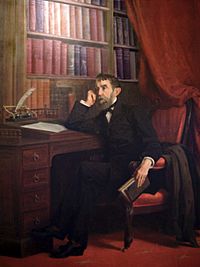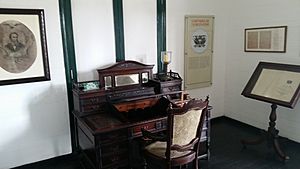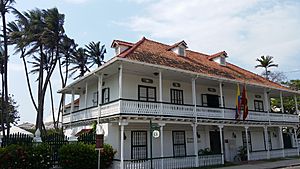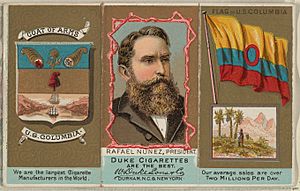Rafael Núñez (politician) facts for kids
Quick facts for kids
Rafael Núñez Moledo
|
|
|---|---|

1891 oil painting by Epifanio Garay
|
|
| 1st President of Colombia | |
| In office April 1, 1886 – September 18, 1894 |
|
| Vice President | Miguel Antonio Caro (1892–1894) Eliseo Payán Hurtado (1886–1892) |
| Preceded by | Office established |
| Succeeded by | Miguel Antonio Caro |
| 14th President of the United States of Colombia | |
| In office August 11, 1884 – April 1, 1886 |
|
| Preceded by | José Eusebio Otálora Martínez |
| Succeeded by | Office abolished |
| 10th President of the United States of Colombia | |
| In office April 8, 1880 – April 1, 1882 |
|
| Preceded by | Julián Trujillo Largacha |
| Succeeded by | Francisco Javier Zaldúa |
| 15th President of the Sovereign State of Bolívar | |
| In office 1879–1880 |
|
| Preceded by | Benjamin Noguera |
| Succeeded by | Benjamin Noguera |
| 12th President of the Sovereign State of Bolívar | |
| In office 1876–1877 |
|
| Preceded by | Eugenio Baena |
| Succeeded by | Manuel González Carazo |
| Personal details | |
| Born |
Rafael Wenceslao Núñez Moledo
September 25, 1825 Cartagena de Indias, Bolívar, Colombia |
| Died | September 18, 1894 (aged 68) Cartagena de Indias, Bolívar, Colombia |
| Resting place | El Cabrero Hermitage, Cartagena de Indias |
| Political party | Liberal Party (1848-1886) National Party<(1886-1894) |
| Spouses | María de los Dolores Gallegos Martínez(1851-1872) Soledad Román Polanco (1877-1894) |
| Alma mater | University of Cartagena |
| Profession | Lawyer |
| Signature |  |
| Nickname | El Regenerador |
| Military service | |
| Allegiance | Colombia (Liberal Party) |
| Branch/service | National Army of Colombia |
| Battles/wars | War of the Supremes |
|
|
Rafael Wenceslao Núñez Moledo (born September 28, 1825 – died September 18, 1894) was an important Colombian writer, lawyer, journalist, and politician. He was elected president of Colombia twice, first in 1880 and again in 1884. Núñez led a big change in Colombia called the "Regeneration" process. This led to the Colombian Constitution of 1886, which was the main law of the country for a very long time, until 1991.
Contents
Early Life and Education
Rafael Núñez was the first of three children. His parents were Dolores García Moledo and Colonel Francisco Núñez García. They got married in October 1824.
When he was 15, Núñez joined rebel troops. He fought in the War of the Supremes. This was a civil war in Colombia.
Not much is known about his very early years. But we do know he worked as a judge in Chiriquí, Panama, in 1848.
Becoming a Politician
Núñez was only 15 when he took part in the War of the Supremes in 1840. This was one of Colombia's first civil wars. It happened because some leaders in the southern provinces rebelled against the government. Núñez joined the rebels and helped attack his own hometown, Cartagena.
After the war, he went to college. He earned a law degree from the Universidad del Magdalena e Istmo in 1844.
In 1848, Núñez started a newspaper called La Democracia in Cartagena. He wanted to support General José María Obando for president. Obando had been a leader in the War of the Supremes.
That same year, Obando became governor of Cartagena Province. He made Núñez his Chief of Staff. This was the start of Núñez's political career. He held this job until 1853.
When Obando became president, Núñez moved to Bogotá. He became a member of the Colombian Congress. There, he became known for disagreeing with the ideas of Manuel Murillo Toro.
In 1854, there was a coup against President Obando. Núñez went into hiding. But then he was elected governor of the Bolívar department. This helped defeat the coup leader, José María Melo.
The new president, Manuel María Mallarino, made Núñez the Minister of War in 1855. Later, he became the Minister of the Treasury. He did a great job as Treasury Minister, which made him well-known. In 1855, he also published his first book of political essays, called La Federación.
Later, he served as Minister of the Treasury again under President Tomás Cipriano de Mosquera. He briefly represented Panama at the Convention of Ríonegro. This meeting created the Constitution of Rionegro.
In 1863, Núñez left Colombia. He lived in New York City for two years. During this time, he wrote for newspapers in Colombia and Spain. Then, he became the Colombian consul in Le Havre, France. Later, he was appointed consul in Liverpool, England.
He came back to Colombia in 1876. He was nominated to run for president that year but did not win. However, he was elected as a senator for the State of Bolívar.
From 1878 to 1888, he wrote many important articles. These articles were about changing the country's laws. He wrote for newspapers like La Luz and La Nación in Bogotá, and El Porvenir and El Impulso in Cartagena. He also wrote the words for the Colombian national anthem.
Presidential Terms and the Regeneration
Núñez was elected President of Colombia for the 1880-1882 term. He was re-elected president in 1884. This time, he had the support of the Conservative Party. He started a big movement he called the "Regeneration".
The 1886 Constitution
Núñez was the main person behind the La Regeneración (Regeneration) movement of 1884. This movement led to a new Constitution for Colombia in 1886.
The Regeneration plan was against many of the liberal changes made in the Constitution of Rionegro. The Regeneration's success changed Colombia from a system where states had a lot of power to a system with a strong central government and president.
Some liberal leaders did not like Núñez's ideas. They started another civil war in 1884 and 1885. But the conservative forces supporting President Núñez won against the liberal troops in 1885. After this victory, Núñez famously said: "Sirs, the Constitution of 1863 is no more."
On September 10, 1885, Núñez called for a special meeting. Two representatives from each state came together to create a new Constitution. This meeting started on November 11, 1885.
The new Colombian Constitution of 1886 was a huge achievement for Núñez. He worked on it with Miguel Antonio Caro. This Constitution, with some small changes, was used until 1991.
The new Constitution:
- Made the central government much stronger.
- Changed the country's name from the United States of Colombia to the Republic of Colombia.
- Re-established strong ties with the Vatican (the head of the Catholic Church).
- Made Catholicism the official religion.
- Put education in the hands of the Catholic church.
- Changed presidential terms from two years to six years.
- Made Congress responsible for electing the president.
- Changed the old states into Departments. These departments would be led by a governor chosen by the president. This gave the president a lot of power.
Núñez was re-elected president in 1886 and again in 1892. However, he did not take office for his last term. His health was getting worse, and he had moved back to Cartagena. His vice-president, Miguel Antonio Caro, became the acting president from 1892 to 1898.
Even though he was not directly involved in the government, Núñez remained an important political figure. His letters, articles, and essays were very influential. Many politicians visited him in Cartagena. His health continued to get worse. He died on September 18, 1894, after a fever. Núñez was still officially the president when he passed away.
His Legacy
In his first time as president, Núñez brought peace and order to the country. This made him very popular. He allowed Catholic bishops, who had been sent away, to return to Colombia.
He also created the Military Academy and the National Academy of Music. He started the international telegraph service. This allowed people to send messages across countries. He also re-established diplomatic relationships with Spain. These ties had been broken since Colombia's War of Independence. He signed trade and cultural agreements with France and the United Kingdom.
During his second time as president, Núñez led a major change in Colombia's political system. This led to the new Colombian Constitution of 1886.
Writings and Mentions
In 1874, while in Europe, many of his most important writings were published.
Núñez wrote the words for Colombia's national anthem, called ¡Oh Gloria Inmarcesible!.
Rafael Núñez is also mentioned in Gabriel García Márquez's famous 1985 novel, Love in the Time of Cholera.
See also
 In Spanish: Rafael Núñez para niños
In Spanish: Rafael Núñez para niños




